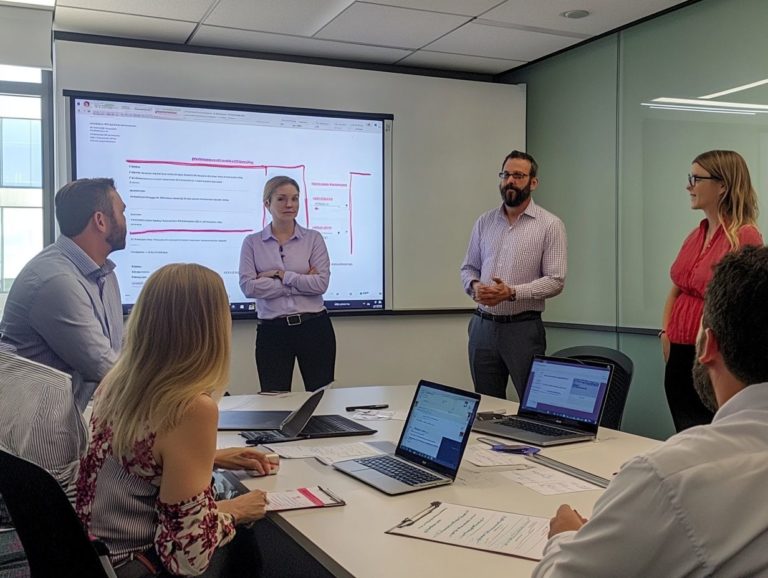How to Build a Culture of Continuous Improvement
In today’s fast-paced business landscape, building a culture of ongoing improvement is paramount for any organization aiming to maintain a competitive edge.
Grasping the essence of continuous improvement and its importance can lay the groundwork for transformative change. This article also offers practical steps for implementing improvement strategies, addressing common challenges, and highlighting the myriad benefits that arise from adopting this proactive mindset.
Whether you find yourself in a leadership role eager to drive change or as an employee passionate about making a difference, this guide offers valuable insights to elevate your organization s effectiveness and overall satisfaction.
Contents
- Key Takeaways:
- Understanding Continuous Improvement
- Key Elements of a Culture of Continuous Improvement
- Implementing Continuous Improvement in Your Organization
- Challenges and Solutions for Building a Culture of Continuous Improvement
- Benefits of a Culture of Continuous Improvement
- Frequently Asked Questions
- What does it mean to build a culture of continuous improvement?
- What are the benefits of building a culture of continuous improvement?
- How can leaders promote a culture of continuous improvement?
- What are some common barriers to building a culture of continuous improvement?
- How can organizations sustain a culture of continuous improvement?
- What role do employees play in building a culture of continuous improvement?
Key Takeaways:

- Continuous improvement is an ongoing effort to enhance processes and systems within an organization.
- Building a culture of ongoing improvement requires leadership support, clear goals, and a focus on continuous learning and adaptability.
- To successfully implement these improvements, organizations must identify areas for growth, create a plan, and regularly measure progress and make adjustments.
Understanding Continuous Improvement
Understanding continuous improvement is essential for organizations aiming for great performance in today s ever-evolving business landscape. It encompasses a systematic approach to refining processes, products, and services, fostering a culture that engages leadership and enables every employee.
By emphasizing small improvements, you can pinpoint and implement ideas that resonate with your unique needs while aligning with your organization’s broader culture and performance management goals. This method boosts employee engagement and creates lasting improvements, ultimately enhancing customer satisfaction and contributing to your organization s overall success.
Definition and Importance
Continuous improvement is all about your ongoing effort to enhance products, services, or processes incrementally over time, and it s key to achieving great performance.
This approach is crucial as it cultivates a culture that values innovation and adaptability, helping you stay competitive in a rapidly changing market. By systematically identifying inefficiencies and implementing enhancements, you not only streamline operations but also elevate customer satisfaction levels.
For example, a well-known automotive manufacturer successfully employed continuous improvement techniques. They achieved a significant reduction in production defects and bolstered customer loyalty. Similarly, a global tech firm streamlined its software development process using agile methodologies, which focus on flexibility and quick responses to change, resulting in quicker product releases and improved user feedback.
These initiatives show that your commitment to continuous improvement can profoundly impact both operational efficiency and overall customer experience.
Key Elements of a Culture of Continuous Improvement
Establishing a culture of continuous improvement necessitates several foundational elements that work together to create an environment ripe for sustainable growth and adaptation.
Engaged leadership plays a pivotal role, as leaders set the tone for a culture where employee engagement flourishes and innovation is not just welcomed it s celebrated.
It’s crucial for organizations to articulate clear goals and establish metrics and indicators that measure progress. This approach enables continuous learning and adaptability in processes and practices, aligning with the overarching vision of the organization.
Embrace continuous improvement today and watch your organization thrive!
Leadership Support and Employee Engagement
Leadership support is essential for cultivating a culture of continuous improvement.
Engaged leaders like you inspire and motivate employees to actively participate in the process.
When you prioritize open communication and collaboration, you create an environment where team members feel valued and enabled to share their ideas.
For instance, by implementing regular feedback sessions, you facilitate the exchange of new ideas while reinforcing employees’ ownership over their work.
Recognizing individual contributions through awards or acknowledgment in meetings can significantly elevate morale and foster a sense of community.
Ultimately, by adopting these leadership strategies, you can cultivate a workforce that is not only willing to improve but also deeply committed to the ongoing evolution of their collective goals.
Set Clear Goals and Measure Success!
Setting clear goals and defining metrics is absolutely essential for tracking your progress in continuous improvement initiatives and ensuring accountability.
These goals should resonate with your organization s overall vision, creating a roadmap that guides your teams toward their desired outcomes.
By aligning these metrics with strategic objectives, you can effectively gauge performance and pinpoint areas for enhancement.
These metrics serve as vital benchmarks, allowing your teams to measure their advancements over time.
Keeping transparency throughout this process builds trust and encourages collaboration, ensuring everyone knows their role in achieving collective success.
Ultimately, this alignment not only drives performance but also nurtures a culture of continuous improvement throughout your organization.
Embrace Learning and Adapt Like a Pro!

Continuous learning and adaptability are essential elements of a sustainable culture of improvement, allowing you to respond effectively to changing circumstances and innovative ideas.
By prioritizing these qualities, you enable your teams to innovate and build strength in the face of challenges.
- Regular training sessions
- Cross-departmental collaborations
- Mentorship programs
These strategies foster an environment where knowledge sharing flourishes.
Encouraging employees to participate in workshops and connect with external thought leaders opens the door to fresh perspectives, igniting creativity.
Establishing feedback loops ensures that lessons learned inform future strategies, reinforcing a culture that celebrates adaptability.
This vibrant learning atmosphere empowers your organization to confidently navigate uncertainties and seize new opportunities!
Implementing Continuous Improvement in Your Organization
Implementing continuous improvement within your organization requires a structured approach that starts with pinpointing areas needing enhancement and crafting a comprehensive plan to tackle them.
This process often involves conducting Kaizen events, team meetings to brainstorm and improve processes, where your teams come together to brainstorm and execute innovative ideas aimed at boosting efficiency and minimizing waste.
By setting clear benchmarks and consistently measuring progress, you can make necessary adjustments, ensuring that your continuous improvement initiatives align seamlessly with both your short-term objectives and long-term goals.
Identifying Areas for Improvement
Identifying areas for improvement is your inaugural step in the continuous improvement journey, demanding a meticulous assessment of your current practices and performance metrics.
This evaluation often entails gathering insights from diverse sources, including employee feedback, which can uncover hidden challenges and unveil opportunities for growth.
Performance metrics are equally essential, providing concrete data that highlights where performance may be lacking.
Customer satisfaction surveys offer invaluable perspectives, pinpointing gaps in service or product quality.
All these elements coalesce seamlessly when engaged leadership is at the helm.
Such leaders are crucial in cultivating a culture of transparency and accountability, ensuring that insights are not only acknowledged but also acted upon, paving the way for sustained development.
Start today! Gather your team and identify one area to improve.
Creating a Plan and Setting Goals
Creating a detailed plan and setting clear goals are essential components in your journey of continuous improvement. They guide your organization s efforts and resource allocation.
These elements streamline your operations and cultivate a culture of accountability among your teams. By embracing the SMART criteria Specific, Measurable, Achievable, Relevant, and Time-bound you can craft actionable plans that drive performance.
For instance, imagine a manufacturing company setting a specific goal to reduce production errors by 15% within six months. This ensures the target is quantifiable and realistic. Or consider a tech startup aiming to boost customer satisfaction by 20% over the next quarter through targeted feedback initiatives.
These examples illustrate how establishing clarity in your goals enhances tracking of progress and outcomes. This makes your improvement efforts effective and sustainable.
Measuring Progress and Making Adjustments
Measuring progress through established metrics measurable data points and indicators is crucial for understanding the effectiveness of your continuous improvement initiatives. This allows for making necessary adjustments.
Regularly reviewing these metrics provides invaluable insights into which strategies yield results and where challenges may arise. For organizations eager to boost their performance, this data serves as a compass, guiding well-considered choices.
By analyzing trends and patterns, you can pinpoint areas for intervention, ensuring effective resource allocation. Embracing a flexible approach enables your teams to pivot swiftly based on gathered insights. This might involve refining existing processes or venturing into new opportunities.
Maintaining an open dialogue about these findings cultivates a culture of continuous learning. It transforms success into a collaborative endeavor.
Challenges and Solutions for Building a Culture of Continuous Improvement
Building a culture of continuous improvement comes with exciting challenges! You may encounter resistance to change, a lack of employee engagement, and sometimes even insufficient leadership support.
These hurdles can complicate your efforts, but recognizing them is the first step toward fostering a thriving environment of ongoing enhancement.
Common Obstacles and How to Overcome Them

Common obstacles to establishing a culture of continuous improvement often include employee apathy, inadequate leadership commitment, and ineffective communication channels.
These challenges can stifle innovation and hinder overall progress within an organization. Employee apathy typically arises when teams feel disconnected from the organization s goals or fail to recognize the value of their contributions. This leads to a disengaged workforce.
Inadequate leadership commitment may surface as a lack of vision and insufficient resources for nurturing a culture of enhancement. When communication channels fall short, critical feedback and ideas for improvement can go unheard, stalling your organization s growth potential.
Companies like Toyota and 3M have successfully tackled these challenges by implementing robust employee engagement programs, committing to ongoing training, and fostering open communication. For instance, 3M encourages employees to dedicate 15% of their workweek to projects they re passionate about, reigniting motivation and spurring innovative thinking.
Benefits of a Culture of Continuous Improvement
Cultivating a culture of continuous improvement offers a multitude of benefits that significantly impact your organization. You ll find improved efficiency, heightened employee satisfaction, and increased customer contentment all vital ingredients for long-term success.
This culture encourages innovation and accountability, enabling your employees to take ownership of their improvement ideas. As a result, you ll foster a more engaged workforce, leading to enhanced quality in both products and services.
Now, take action! Start implementing continuous improvement strategies today for a thriving future!
Improved Efficiency and Productivity
One of the most significant advantages of cultivating a culture of continuous improvement is the remarkable enhancement in efficiency and productivity across various processes.
This transformation takes shape through systematic evaluation and workflow refinement. It minimizes redundancies and optimizes resource use. For example, consider a manufacturing firm that embraced lean principles; it achieved a 30% reduction in production time while slashing material waste by 25%, ultimately elevating overall output.
Metrics like cycle time reduction and waste percentages serve as key indicators of success. Case studies from companies implementing Kaizen, a method for continuous improvement, reveal that incremental changes can lead to substantial long-term gains.
By fostering a mindset focused on continuous enhancement, you can significantly elevate your organization s performance.
Increased Employee Satisfaction and Retention
A culture of continuous improvement can significantly boost your employee satisfaction and retention by actively involving your team in decision-making and recognizing their contributions.
This approach cultivates a sense of ownership among your team members and fosters an environment where they feel valued and heard. For instance, organizations like Google have embraced practices that prioritize open communication and collaborative problem-solving, allowing employees to take an active role in shaping their work environment. Similarly, companies such as Zappos empower their workforce with autonomy and support, resulting in higher levels of engagement.
These strategies create a positive feedback loop. As your employees feel more invested in their roles, their commitment to the organization deepens, leading to lower turnover rates and a richer workplace culture.
Better Quality and Customer Satisfaction
Embracing a culture of continuous improvement supercharges the quality of your products and services, resulting in greater customer satisfaction and loyalty.
When you adopt this culture, you can leverage various metrics, such as Net Promoter Scores (NPS) and Customer Satisfaction Scores (CSAT), to accurately assess customer perceptions. For example, a prominent manufacturing company adopted Lean methodologies, which not only streamlined their operations but also elevated their CSAT scores by an impressive 25% within a year.
Insights from case studies show that businesses dedicated to understanding customer feedback can effectively tailor their offerings, leading to improved retention rates and increased engagement. Therefore, by fostering quality improvements, you can transform processes while simultaneously building lasting relationships with your customers.
Frequently Asked Questions
-
What does it mean to build a culture of continuous improvement?
Building a culture of continuous improvement means creating an environment where employees are encouraged and empowered to constantly seek ways to improve their work processes and systems, including insights on how to foster a culture of leadership.
-
What are the benefits of building a culture of continuous improvement?
-
Some benefits of building a culture of continuous improvement include increased efficiency, higher quality products and services, better employee engagement and satisfaction, and ultimately, improved business results.
-
How can leaders promote a culture of continuous improvement?
-
Leaders can promote a culture of continuous improvement by setting the example themselves, providing resources and support for improvement initiatives, and recognizing and rewarding employees for their efforts and ideas.
-
What are some common barriers to building a culture of continuous improvement?
-
Some common barriers may include resistance to change, lack of resources or time, fear of failure, and a lack of communication and collaboration within the organization.
-
How can organizations sustain a culture of continuous improvement?
-
Sustaining a culture of continuous improvement requires ongoing commitment and dedication from leaders, as well as regular communication and training for employees. It is also important to celebrate successes and recognize the impact of continuous improvement efforts.
What role do employees play in building a culture of continuous improvement?
Want to foster a workplace where everyone thrives? Employees are key to building a culture of continuous improvement!
They are involved in daily processes and can spot areas that need improvement. It s essential for them to feel supported and empowered to suggest changes.





